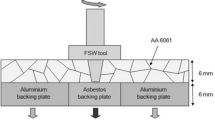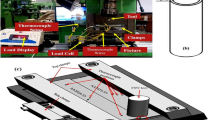Abstract
This study focuses on the challenges with butt joining of 25 mm thick aluminum alloy 7175-T79. High-speed (150 mm/min) single-pass friction stir welding was employed as an effective technique for this purpose. The influence of quenching and cooling rate on critical performance level indicators such as joint strength and microstructure was investigated. A series of friction stir welding (FSW) trials, conducted both in air and with a trailing water spray using steel and composite backing plates (BP) revealed distinct hardness distribution in the nugget, heat-affected zone (HAZ), and HAZ minimum hardness. The influence of trailing water spray (TWS) on joint efficiency proves more significant than the impact of BP combinations, owing to their markedly different contributions to the quenching process. The ultimate tensile strength of TWS welds exhibited a notable 14% increase compared to the air welds. TWS also introduces multifaceted effects on FSW, including a reduction in processing temperature, an increase in X and Z forces, and decrease in Y force, and a narrowing of the HAZ. Lastly, the study employs digital image correlation (DIC)-based fracture mode analysis and grain size measurements, establishing correlations with the observed micro-hardness distribution.








Similar content being viewed by others
References
Alikin, R., Basovich, V., Gelfgat, M., Tikhonov, V., Chizhikov, V (2007) Russian aluminum alloys for ultra deep water production risers, international conference on subsea technologies, St. Petersburg, Russia.
Gelfgat, M., Grebtsov, N., Podrazhansky, A., Vygodsky, B., Tikhonov, V., Shaposhnikov, V., Chizhikov, V (2004) High-Strength Aluminun Alloys for Deepwater Riser Applications, Offshore Technology Conference, OTC, pp. OTC-16185-MS.
Sinyavskii, V., & Kalinin, V. (2005). Marine corrosion and protection of aluminum alloys according to their composition and structure. Protection of metals, 41(4), 317–328.
Thomas, W.M., Nicholas, E.D., Needham, J.C., Murch, M.G., Temple-Smith, P., Dawes, C.J., (1993) Improvements relating to friction welding (friction stir welding and friction plunge welding). The Welding Institute, PCT World, Patent Number 0653265A2, in: E.P. Office (Ed.)
Mishra, R.S., Komarasamy, M., (2016) Friction stir welding of high strength 7XXX aluminum alloys, Butterworth-Heinemann
Threadgill, P., Leonard, A., Shercliff, H., & Withers, P. (2009). Friction stir welding of aluminium alloys. International Materials Reviews, 54(2), 49–93.
Doshi, S. J., Gohil, A., Mehta, N., & Vaghasiya, S. (2018). Challenges in fusion welding of Al alloy for body in white. Materials Today: Proceedings, 5(2), 6370–6375.
Mononen, J., Sirén, M., & Hänninen, H. (2003). Cost comparison of FSW and MIG welded aluminium panels. Welding in the World, 47(11), 32–35.
Dehghani, K., Ghorbani, R., & Soltanipoor, A. (2015). Microstructural evolution and mechanical properties during the friction stir welding of 7075-O aluminum alloy. The International Journal of Advanced Manufacturing Technology, 77(9), 1671–1679.
Zhao, Y., Wang, Q., Chen, H., & Yan, K. (2014). Microstructure and mechanical properties of spray formed 7055 aluminum alloy by underwater friction stir welding. Materials & Design, 56, 725–730.
Linton, V. M., & Ripley, M. I. (2008). Influence of time on residual stresses in friction stir welds in agehardenable 7xxx aluminium alloys. Acta Materialia, 56(16), 4319–4327.
Reynolds, A. P., Tang, W., Khandkar, Z., Khan, J. A., & Lindner, K. (2005). Relationships between weld parameters, hardness distribution and temperature history in alloy 7050 friction stir welds. Science and Technology of Welding and Joining, 10(2), 190–199.
Alali Alkhalaf, A., Tesleva, A., Polyakov, P., Moschinger, M., Fritsche, S., Morozova, I., Naumov, A., Isupov, F., Pina Cipriano, G., & Amancio-Filho, S. T. (2021). Modified friction stir welding of Al–Zn–Mg–Cu aluminum alloy. In Y. Hovanski, Y. Sato, P. Upadhyay, A. A. Naumov, & N. Kumar (Eds.), Friction stir welding and processing XI (pp. 43–51). Cham: Springer.
Canaday, C. T., Moore, M. A., Tang, W., & Reynolds, A. P. (2013). Through thickness property variations in a thick plate AA7050 friction stir welded joint. Materials Science and Engineering: A, 559, 678–682.
Feng, A. H., Chen, D. L., & Ma, Z. Y. (2010). Microstructure and cyclic deformation behavior of a friction-stir-welded 7075 Al alloy. Metallurgical and Materials Transactions A, 41(4), 957–971.
Fuller, C. B., Mahoney, M. W., Calabrese, M., & Micona, L. (2010). Evolution of microstructure and mechanical properties in naturally aged 7050 and 7075 Al friction stir welds. Materials Science and Engineering: A, 527(9), 2233–2240.
Golezani, A. S., Barenji, R. V., Heidarzadeh, A., & Pouraliakbar, H. (2015). Elucidating of tool rotational speed in friction stir welding of 7020–T6 aluminum alloy. The International Journal of Advanced Manufacturing Technology, 81(5), 1155–1164.
Jata, K. V., Sankaran, K. K., & Ruschau, J. J. (2000). Friction-stir welding effects on microstructure and fatigue of aluminum alloy 7050–T7451. Metallurgical and Materials Transactions A, 31(9), 2181–2192.
Komarasamy, M., Alagarsamy, K., Ely, L., & Mishra, R. S. (2018). Characterization of 3″through-thickness friction stir welded 7050–T7451 Al alloy. Materials Science and Engineering: A, 716, 55–62.
Lezaack, M. B., & Simar, A. (2021). Avoiding abnormal grain growth in thick 7XXX aluminium alloy friction stir welds during T6 post heat treatments. Materials Science and Engineering: A, 807, 140901.
Magnusson, L., Kallman, L., (2000) Mechanical properties of friction stir welds in thin sheet of aluminium 2024, 6013 and 7475, Second international symposium on FSW, Gothenburg, Sweden, pp. 1555–1620
Mao, Y., Ke, L., Liu, F., Liu, Q., Huang, C., & Xing, L. (2014). Effect of tool pin eccentricity on microstructure and mechanical properties in friction stir welded 7075 aluminum alloy thick plate. Materials & Design, 1980–2015(62), 334–343.
Nelson, T. W., Steel, R. J., & Arbegast, W. J. (2013). In situthermal studies and post-weld mechanical properties of friction stir welds in age hardenable aluminium alloys. Science and Technology of Welding and Joining, 8(4), 283–288.
Rathinasuriyan, C., Pavithra, E., Sankar, R., & Kumar, V. S. (2021). Current status and development of submerged friction stir welding: A review. International Journal of Precision Engineering and Manufacturing-Green Technology, 8, 687–701.
Upadhyay, P., & Reynolds, A. (2014). Effect of Backing Plate Thermal Property on Friction Stir Welding of 25-mm-Thick AA6061. Metallurgical and Materials Transactions A, 45(4), 2091–2100.
Upadhyay, P., & Reynolds, A. P. (2010). Effects of thermal boundary conditions in friction stir welded AA7050-T7 sheets. Materials Science and Engineering: A, 527(6), 1537–1543.
Reza-E-Rabby, M., Das, H., Wang, T., Komarasamy, M., & Whalen, S. A. (2023). Grant, High-speed friction stir butt welding of 25.4 mm thick 7175–T79 aluminum alloy. Manufacturing Letters, 38, 1–5.
Wang, T., Reza-E-Rabby, M., Das, H., Grant, G. J., & Whalen, S. (2023). Friction stir welding of thick 7175 aluminium alloy plates for deepwater riser applications. Science and Technology of Welding and Joining, 38, 1–10.
Sullivan, A., & Robson, J. (2008). Microstructural properties of friction stir welded and post-weld heat-treated 7449 aluminium alloy thick plate. Materials Science and Engineering: A, 478(1–2), 351–360.
Hassan, K. A., Norman, A., Price, D., & Prangnell, P. (2003). Stability of nugget zone grain structures in high strength Al-alloy friction stir welds during solution treatment. Acta Materialia, 51(7), 1923–1936.
Sun, T., Reynolds, A., Roy, M., Withers, P., & Prangnell, P. (2018). The effect of shoulder coupling on the residual stress and hardness distribution in AA7050 friction stir butt welds. Materials Science and Engineering: A, 735, 218–227.
Hassan, K. A. A., Prangnell, P. B., Norman, A. F., Price, D. A., & Williams, S. W. (2013). Effect of welding parameters on nugget zone microstructure and properties in high strength aluminium alloy friction stir welds. Science and Technology of Welding and Joining, 8(4), 257–268.
Mackenzie, J. J. B. (1958). Second paper on statistics associated with the random disorientation of cubes. Biometrika, 45(1–2), 229–240.
Mao, Y., Ke, L., Chen, Y., Liu, F., & Xing, L. (2018). Technology, Inhomogeneity of microstructure and mechanical properties in the nugget of friction stir welded thick 7075 aluminum alloy joints. Journal of Materials Science & Technology, 34(1), 228–236.
Acknowledgements
This research was funded by the U.S. Department of Energy (DOE), Office of Fossil Energy and Carbon Management under Field Work Proposal 71971. The authors would like to acknowledge the guidance and support from Roy Long and Dave Cercone, Technology Managers, Offshore Oil and Gas, National Energy Technology Laboratory. Pacific Northwest National Laboratory is operated by Battelle for DOE under contract DE-AC05-76RL01830. The authors would like to thank Anthony Guzman, Timothy J. Roosendaal, Nathan Canfield, and Angel Ortiz for their assistance in preparing and testing samples. Finally, the authors would like to extend their appreciation to Mr. Douglas Waldron, President, Xymat. For his continuous support to this project including providing the feedstock materials.
Author information
Authors and Affiliations
Contributions
Hrishikesh Das: Investigation, Methodology, Writing—review & editing. Md. Reza-E-Rabby: Investigation, Methodology, Writing—review & editing. Scott A. Whalen: Supervision, Writing—review & editing. Piyush Upadhyay: Writing – review & editing. Glenn J. Grant: Funding acquisition, Supervision, Writing—review & editing.
Corresponding author
Ethics declarations
Conflict of Interest
The authors declare that they have no known competing financial interests or personal relationships that could have appeared to influence the work reported in this paper.
Additional information
Publisher's Note
Springer Nature remains neutral with regard to jurisdictional claims in published maps and institutional affiliations.
Supplementary Information
Below is the link to the electronic supplementary material.
Rights and permissions
About this article
Cite this article
Das, H., Reza-E-Rabby, M., Whalen, S.A. et al. Impact of Backing Plate and Thermal Boundary Conditions for High-Speed Friction Stir Welding of 25-mm Thick Aluminum Alloy 7175-T79. Int. J. of Precis. Eng. and Manuf.-Green Tech. (2024). https://doi.org/10.1007/s40684-024-00607-x
Received:
Revised:
Accepted:
Published:
DOI: https://doi.org/10.1007/s40684-024-00607-x




